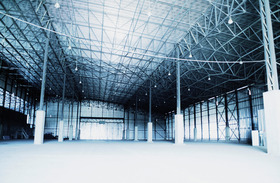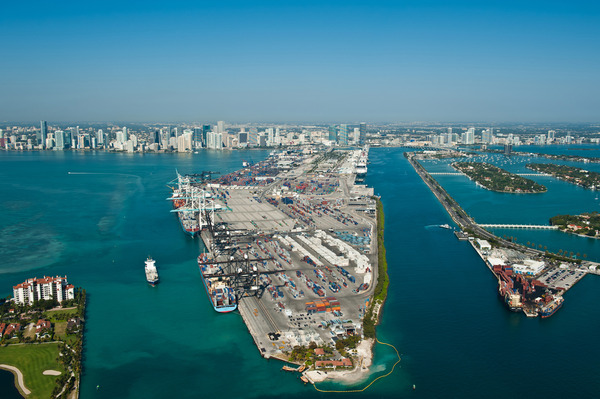The WPJ
THE WORLD PROPERTY JOURNALReal Estate Facts Not Fiction
Commercial Real Estate News

U.S. Industrial Real Estate Market Enjoying a Resurgence in Late 2012
Commercial News » North America Commercial News Edition | By Hortense Leon | February 20, 2013 9:15 AM ET
 The industrial real estate market is making a comeback. Net demand for warehouse space was 40.8 million square feet in fourth quarter 2012, making it the second strongest quarter since record-keeping began in 1993 at Cassidy Turley, a commercial real estate company with offices around the US.
The industrial real estate market is making a comeback. Net demand for warehouse space was 40.8 million square feet in fourth quarter 2012, making it the second strongest quarter since record-keeping began in 1993 at Cassidy Turley, a commercial real estate company with offices around the US.Industrial vacancies are tightening quickly, according to a report by Cassidy Turley. In the fourth quarter, vacancies declined by 20 basis points from the previous quarter to 8.9%. The national industrial vacancy rate was at its lowest point in three years in the fourth quarter of 2012. For certain product, such as big box distribution centers, the vacancy rate was below 4% in some locations, according to Cassidy Turley. With vacancies quickly eroding, it won't be long before rents escalate, according to the report.
The strongest demand for industrial real estate was in the Midwest and South, regions that accounted for 75% of the absorption in the fourth quarter, according to the Cassidy Turley report.
One of the biggest success stories over the last six to eight months has been the resurgence of the industrial real estate market in Indianapolis, where the vacancy rate was at an historical low for multi-tenant space, 3.3%, in fourth quarter 2012, according to Jason Tolliver, vice president of research at Cassidy Turley in Indianapolis.
About 3.2 million square feet of spec building is going on right now in the Indianapolis metro, says Tolliver, "a positive harbinger for the market, especially compared to four or five years ago." The area is centrally located and has a vast network of interstate highways, so lots of shipping is done by truck and through Indianapolis' international airport, says Tolliver. Indianapolis has the second largest FedEx hub, after Memphis, in the country, he says. In general, the Midwest is doing well, says Tolliver, partially because of the resurrection of manufacturing, and the rebound of the housing market.
The south is also benefitting from the recovery in the economy. "There is no question that the industrial market is active, especially in the Airport West and Medley markets," which are the most desirable submarkets in Miami and are the closest to Miami International Airport, says Michael Silver, first vice president at CBRE in Miami. "The vacancy factor dropped from 8% to 6% in the second half of last year and rental rates have climbed, depending on location and the size of the building, by 10% to 20% and sales prices have climbed as well," he says, noting that he is only talking about the more modern submarkets, like Airport West.
In Airport West, rental rates were about $7.50 to $8 per square foot gross in the first half of 2012, but in fourth quarter 2012 and today, the average rental rate is $8.50 to $9 per square foot gross," says Silver.
Also in the Airport West market, sales prices per square foot for industrial buildings were in the $80 per square foot range in 2011 and the first half of 2012, but now range from $90 to $110 per square foot, says Silver.
Currently, in Miami, there is about 1.2 million square feet of industrial real estate construction in Miami-Dade County says Silver, all in the Airport West and Medley markets. "This is the first time we are seeing spec building in Miami since mid-2007," he says.
Silver says that one reason for all the spec building in Miami today is that there is a shortage of certain-sized spaces. Also, he says, that there's been a 're-shoring' of jobs as companies are finding that labor costs in low-cost countries, like India and China, are growing. Manufacturers are bringing jobs back to the US, says Silver.
Miami-Dade, as a global city, benefits from the Port of Miami and Miami International Airport, says Silver. When the expansion of the Panama Canal is completed in 2015, that will benefit Miami, he says. The dredging project at the Port of Miami, which is currently in the works, will help accommodate the larger ships, says Silver.
The big question, says Silver, is how much of the merchandise that comes in on Post-Panamax ships (larger ships that will be able to pass through the Panama Canal only after the expansion is complete) will stay in the area and how much will be shipped north. "But enough product will stay here, that there will be a need for several million square feet of new industrial space," he says.
Sign Up Free | The WPJ Weekly Newsletter
Relevant real estate news.
Actionable market intelligence.
Right to your inbox every week.
Real Estate Listings Showcase
Related News Stories
Commercial Real Estate Headlines
- U.S. Commercial Mortgage Delinquencies Rise in Q2, CMBS Loans Lead the Surge
- Tokenization-Focused Real Estate Investment Bank Announced
- Commercial Cap Rates Edge Lower in U.S., Hinting at Market Turn
- WPV Targets New $6 Trillion Digital Real Estate Tokenization Opportunity
- $1 Trillion in Data Center Development Underway Through 2030
- WORLD PROPERTY VENTURES: The 'Anti-VC' of Real Estate Plans Major Capital Raise
- Multifamily Sector Enjoys Record Absorption in U.S. as Supply Slows, Vacancies Drop
- Employee Back-to-Office Attendance Surges in U.S.
- Phnom Penh Commercial Property Sectors Face Crosswinds in 2025
- World Property Bank Announced to Capitalize on Coming Trillion-Dollar Tokenization Boom
- REAL ESTATE PREDICTIONS: Decentralized Events Contract Exchange in Development
- U.S. Architecture Billings Improve Slightly in May
- Tokyo Office Demand Spills into Non-Core Wards in 2025
- AI Hyperscalers Drive Record Data Center Leasing in Early 2025
- Commercial, Multifamily Mortgage Debt in U.S. Hits Record $4.81 Trillion in Early 2025
- U.S. Multifamily Market Rebounds in Early 2025
- U.S. Office Market Experiences Historic Conversion Shift
- New York City Enters New Era of Office-to-Residential Conversions
- World Property Ventures Plans New Capital Raise
- U.S. Commercial Real Estate Lending Rebounds Sharply in Early 2025
- U.S. Multifamily Housing Confidence Declines in Early 2025
- Asia Pacific Commercial Investment Holds Steady in Early 2025
- Carnival Plans New Miami Headquarters Spanning Over 600,000 Square Feet
- Hong Kong Property Investors Take a Wait-and-See Approach Due to U.S. Tariffs
- U.S. Multifamily Buyer and Seller Sentiment Improves in Early 2025
- One Trillion Dollars of America's Commercial Property Loans Mature in 2025
- U.S. West Coast Dominates Self Storage Demand
- Phoenix, Orange County and Inland Empire Emerge as Leading U.S. Industrial Markets
- U.S. Mega Distribution Centers Leasing Activity Grew in 2024
- U.S. Commercial Borrowing to Increase to $583 Billion in 2025, Up 16 Percent Annually
- Demand for U.S. Life Sciences Space Spikes 28 Percent Annually in Late 2024
- Multifamily Property Sector in America Rebounding
- Asia Pacific Commercial Property Investment Spikes 23 Percent in 2024
- U.S. Commercial Property Market Primed for Growth in 2025
- Architecture Industry Sees Mixed Signals as 2025 Approaches
- Global Data Center Demand Spikes in 2025
- 2025 Prediction: U.S. Commercial Investment Recovery Expected to Gain Traction
- Holiday Retail Sales for 2024 to Hit Record $1 Trillion
- Tech, AI Industries Drive Largest Share of Office Leasing Activity in U.S.
- Commercial Real Estate Lending in U.S. Enjoys Strong Growth in Q3
Reader Poll
Marketplace Links
This website uses cookies to improve user experience. By using our website you consent in accordance with our Cookie Policy. Read More








